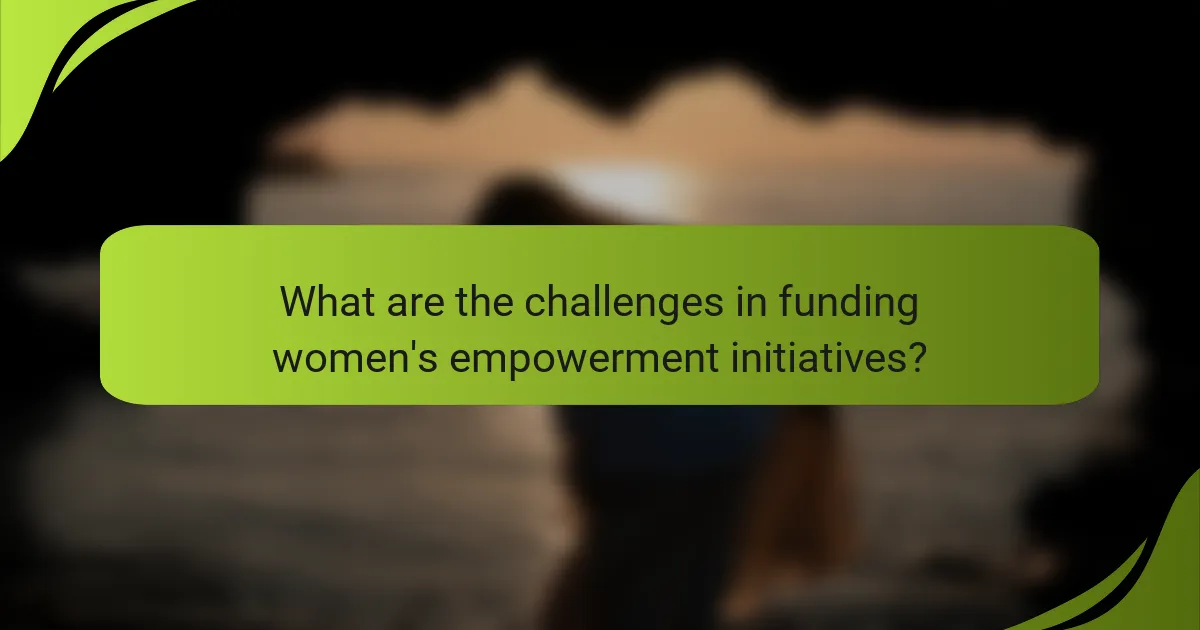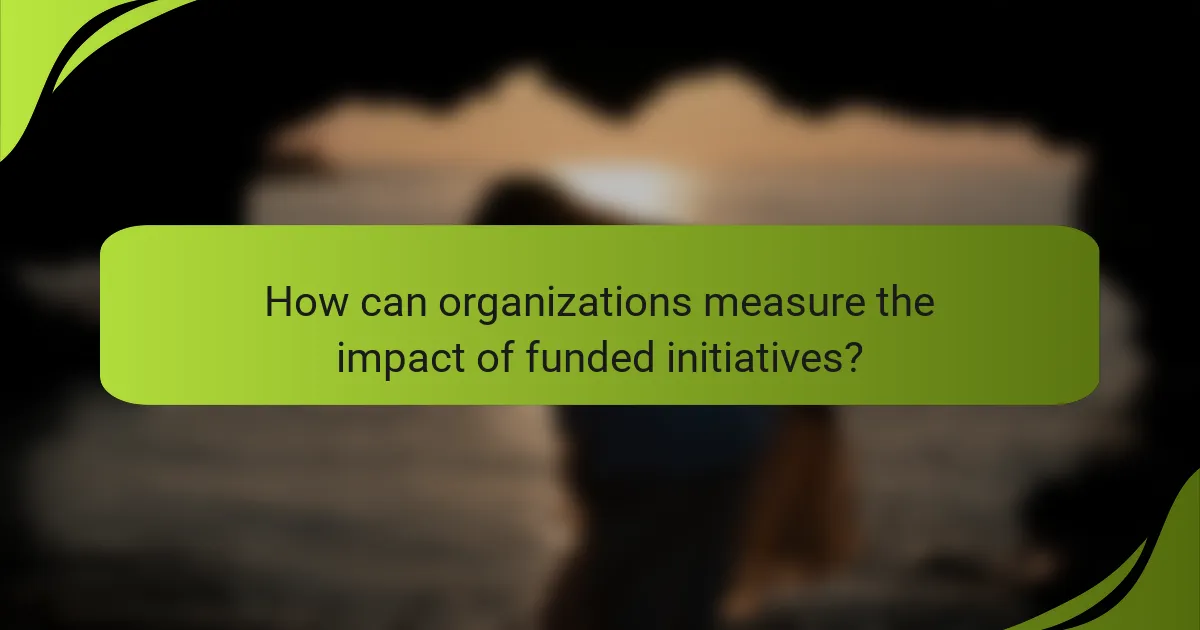Addressing funding challenges for women’s empowerment initiatives is crucial for promoting gender equality and supporting women’s rights. Organizations often encounter obstacles such as limited resources and a lack of awareness among potential donors. By exploring diverse funding sources and strategic partnerships, NGOs can enhance their financial sustainability and effectively advance their missions.

What are the funding solutions for women’s empowerment initiatives?
Funding solutions for women’s empowerment initiatives include various sources such as grants, crowdfunding, corporate sponsorships, and government programs. Each option offers unique benefits and considerations that can help organizations secure the necessary resources to support their missions.
Grants from organizations like Global Fund for Women
Grants from organizations such as the Global Fund for Women provide essential financial support for women’s empowerment projects. These grants often focus on specific areas like education, health, and economic development, allowing organizations to tailor their initiatives to meet community needs.
To apply for these grants, organizations typically need to submit a detailed proposal outlining their objectives, budget, and expected outcomes. It’s crucial to align the project with the funder’s mission and demonstrate a clear impact on women’s lives.
Crowdfunding platforms such as GoFundMe
Crowdfunding platforms like GoFundMe enable individuals and organizations to raise funds directly from the public. This method can be particularly effective for grassroots initiatives that resonate with personal stories and community support.
Successful crowdfunding campaigns often rely on social media promotion and engaging storytelling. Setting a realistic funding goal and providing regular updates can help maintain donor interest and encourage contributions.
Corporate sponsorships from companies like Nike
Corporate sponsorships from companies such as Nike can provide significant funding and resources for women’s empowerment initiatives. These partnerships often involve financial support, in-kind donations, or promotional assistance, enhancing the visibility of the projects.
When seeking corporate sponsorships, it’s important to identify companies whose values align with the initiative’s goals. Building a strong proposal that highlights mutual benefits can increase the likelihood of securing support.
Government funding programs for gender equality
Government funding programs aimed at promoting gender equality can be a vital source of financial support for women’s empowerment initiatives. These programs may offer grants, loans, or contracts specifically designed to address issues affecting women.
Organizations should research available government programs at local, state, and national levels, as eligibility criteria and application processes can vary. Staying informed about deadlines and required documentation is essential for a successful application.

How can NGOs secure funding for women’s initiatives?
NGOs can secure funding for women’s initiatives through strategic partnerships, grant applications, and innovative fundraising methods. By leveraging local resources and global opportunities, organizations can enhance their financial support and sustainability.
Building partnerships with local businesses
Collaborating with local businesses can provide NGOs with essential resources and funding for women’s initiatives. Businesses may offer financial contributions, in-kind donations, or volunteer support, which can significantly enhance program effectiveness.
To establish these partnerships, NGOs should identify businesses that align with their mission and values. Proposing mutually beneficial projects can attract local companies looking to enhance their corporate social responsibility (CSR) profile.
Applying for international development grants
International development grants are a vital source of funding for women’s initiatives. Organizations should research various grant opportunities offered by governments, foundations, and international agencies that focus on gender equality and women’s empowerment.
When applying for grants, NGOs must carefully follow application guidelines and demonstrate clear objectives and measurable outcomes. Building a strong narrative around the impact of their initiatives can increase the chances of securing funding.
Utilizing social media for fundraising campaigns
Social media platforms are powerful tools for NGOs to raise funds for women’s initiatives. By creating engaging content and campaigns, organizations can reach a wider audience and encourage donations from individuals who are passionate about women’s empowerment.
To maximize effectiveness, NGOs should utilize storytelling techniques, share success stories, and create compelling calls to action. Regularly updating followers and expressing gratitude for their support can help build a loyal donor base.

What are the challenges in funding women’s empowerment initiatives?
Funding women’s empowerment initiatives faces several significant challenges, including a lack of awareness among potential donors and competition for limited resources. These obstacles hinder the growth and sustainability of programs aimed at promoting gender equality and women’s rights.
Lack of awareness among potential donors
Many potential donors are unaware of the specific needs and impacts of women’s empowerment initiatives. This lack of awareness can stem from insufficient marketing or outreach efforts by organizations seeking funding. To address this, initiatives should focus on educating potential donors about the importance of their contributions and the tangible outcomes that can result from their support.
Creating compelling narratives and showcasing success stories can help raise awareness. Engaging in community events or partnerships with influential figures can also enhance visibility and attract interest from donors who may not have previously considered funding women’s initiatives.
Competition for limited funding resources
The competition for funding is intense, as many organizations vie for a finite pool of financial resources. Women’s empowerment initiatives often compete not only with each other but also with various other social causes, making it challenging to secure necessary funds. Organizations must differentiate themselves by clearly articulating their unique value propositions and demonstrating measurable impacts.
Developing strategic partnerships can also help alleviate competition by pooling resources and sharing funding opportunities. Collaborating with other organizations can create a stronger case for funding, as combined efforts may lead to more significant outcomes that attract donor interest.
Barriers in accessing traditional funding sources
Many women’s empowerment initiatives face barriers when trying to access traditional funding sources, such as banks or large grant-making institutions. These barriers can include stringent eligibility criteria, complex application processes, and a lack of established relationships with funders. Organizations should invest time in understanding the requirements of these funding sources and tailor their proposals accordingly.
Networking with funders and attending relevant workshops can help organizations build relationships that facilitate access to funding. Additionally, exploring alternative funding sources, such as crowdfunding or social impact investors, can provide new avenues for financial support that may be less restrictive than traditional methods.

What criteria should be considered when selecting funding sources?
When selecting funding sources for women’s empowerment initiatives, it is crucial to evaluate how well these sources align with your organization’s mission and values, as well as their reputation and reliability. These criteria help ensure that the funding not only supports your goals but also enhances your credibility and sustainability.
Alignment with organizational mission and values
Funding sources should resonate with the core mission and values of your organization. This alignment ensures that the financial support you receive does not compromise your principles or objectives. For example, if your initiative focuses on promoting gender equality, seek out donors who prioritize social justice and women’s rights.
Consider creating a checklist of your organization’s key values and comparing them against potential funders. This can help you quickly identify which sources are a good fit and which may pose ethical dilemmas. Prioritize funders whose missions complement yours, as this can lead to more fruitful partnerships.
Reputation and reliability of funding sources
The reputation and reliability of funding sources are critical factors in maintaining your organization’s credibility. Research potential funders to understand their history, impact, and any controversies associated with them. Reliable funders often have a track record of supporting similar initiatives and can provide testimonials or case studies.
Additionally, consider the stability of the funding source. Look for organizations that have consistent funding practices and a transparent application process. Avoid sources that have a history of abrupt funding cuts or unclear terms, as these can jeopardize your initiative’s success. A good rule of thumb is to prioritize funders with established reputations in the nonprofit sector, as they are more likely to provide ongoing support.

How can organizations measure the impact of funded initiatives?
Organizations can measure the impact of funded initiatives by utilizing various evaluation methods that assess effectiveness and outcomes. These methods provide insights into how well the initiatives are achieving their goals and the extent of their influence on women’s empowerment.
Using key performance indicators (KPIs)
Key performance indicators (KPIs) are quantifiable metrics that help organizations track the success of their initiatives. Common KPIs for women’s empowerment programs may include the number of women trained, the percentage of participants who secure employment, or improvements in income levels.
When selecting KPIs, ensure they align with the specific objectives of the initiative. For instance, if the goal is to enhance financial literacy, track metrics like the number of women completing financial education courses or changes in budgeting behaviors.
Conducting surveys and feedback sessions
Surveys and feedback sessions are essential tools for gathering qualitative data on the experiences of participants. These methods can reveal insights into how initiatives are perceived and their real-world impact on women’s lives.
To effectively conduct surveys, consider using a mix of closed and open-ended questions to capture both quantitative and qualitative data. Regular feedback sessions can also foster a sense of community and encourage participants to share their thoughts on program improvements.

What are the emerging trends in funding women’s empowerment initiatives?
Emerging trends in funding women’s empowerment initiatives include a heightened focus on intersectionality, the rise of impact investing, and the innovative use of technology for fundraising. These trends reflect a growing recognition of the diverse needs of women and the importance of sustainable financial models.
Increased focus on intersectionality in funding
Intersectionality in funding means recognizing that women’s experiences and challenges vary based on race, class, sexuality, and other identities. Funders are increasingly prioritizing initiatives that address these overlapping issues, leading to more tailored and effective solutions.
For example, programs that support women of color or [censured] women often receive targeted funding to ensure their unique challenges are addressed. This approach not only enhances the impact of funding but also promotes inclusivity within the empowerment movement.
Growth of impact investing in women’s programs
Impact investing focuses on generating social and environmental benefits alongside financial returns. This trend is gaining traction in women’s empowerment initiatives, as investors seek to support programs that create measurable change.
Funds directed towards women’s entrepreneurship or health initiatives often highlight their dual goals of profitability and social impact. Investors are encouraged to evaluate potential projects based on their ability to empower women while providing a reasonable return on investment.
Utilization of technology for innovative fundraising
Technology is transforming fundraising for women’s empowerment initiatives through platforms that facilitate online donations, crowdfunding, and social media campaigns. These tools enable organizations to reach broader audiences and engage supporters more effectively.
For instance, crowdfunding platforms allow grassroots organizations to showcase their projects and attract small donations from a global audience. Additionally, leveraging social media can amplify fundraising efforts, making it easier to share stories and mobilize support.


